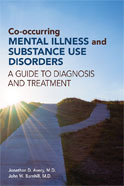Co-occurring Mental Illness and Substance Use Disorders A Guide to Diagnosis and Treatment

Author: Jonathan Avery, M.D., John Barnhill, M.D.
Affiliation:
Publisher: American Psychiatric Association Publishing
Publication Date: 2018
ISBN 10: 1615370552
ISBN 13: 9781615370559
eISBN: 9781615371594
Edition: 1st
Affiliation:
Publisher: American Psychiatric Association Publishing
Publication Date: 2018
ISBN 10: 1615370552
ISBN 13: 9781615370559
eISBN: 9781615371594
Edition: 1st
Description:
Co-occurring Mental Illness and Substance Use Disorders: A Guide to Diagnosis and Treatment provides a clinically detailed, evidence- based, and exhaustive examination of a topic rarely plumbed in psychiatry texts, despite the fact that co-occurring mental illness and substance use disorders are common. The authors argue for a more holistic and integrated approach, calling for clinicians to tactfully but persistently evaluate patients for a broad range of co-occurring disorders before determining appropriate treatment. Focusing on a substance use disorder in isolation, without determining whether another psychiatric disorder is co-occurring, can doom treatment efforts, and the reverse also is true. To help clinicians keep the big picture in mind, the book is organized around 18 cases, each of which addresses a particular diagnostic skill (e.g., assessment), group of disorders commonly comorbid with substance use disorders (e.g., PTSD, eating disorders), specific treatment (e.g., pharmacological interventions), or special population (e.g., adolescents). This case-based approach makes it easy for readers to understand strategies and master transferable techniques when dealing with their own patients. - Because the initial face-to-face sessions are especially important with this patient population, the book includes chapters on the diagnostic assessment and the initial interview, as well as offering interviewing tips throughout to help the clinician develop the necessary care and skill in this arena. Also included is a chapter on integrating motivational interviewing into the treatment.- Each of the 18 cases stands alone, allowing the reader flexibility in using the text. For example, the 18 cases and discussions can be read sequentially, or as needed, depending on the reader's special interest or current need.
Related Titles
